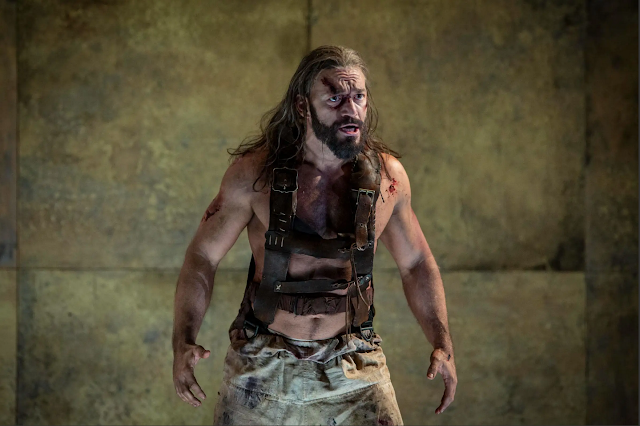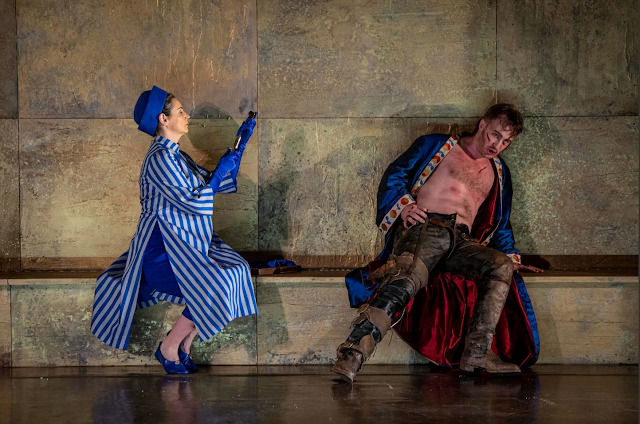 |
| Vivaldi: Bajazet - Gianluca Margheri - Irish National Opera (Photo Kip Carroll) |
Vivaldi Bajazet; Gianluca Margheri, Eric Jurenas, James Laing, Niamh O'Sullivan, Claire Booth, Aoife Miskelly, dir: Adele Thomas, Irish Baroque Orchestra, cond: Peter Whelan; Irish National Opera at the Royal Opera House
Reviewed by Robert Hugill on 12 February 2022 Star rating: (★★★★★)
Vivaldi's Bajazet (also known as Il Tamerlano) was premiered at the end of his operatic career, in 1735 in Verona. It is in fact a pasticcio, Vivaldi combining elements from his back catalogue and arias from other composers to create a new work, a sort of greatest hits piece where the arias from other composers were ones principally associated with two of the greatest singers of the day, the soprano castrato Farinelli and the contralto Vittoria Tesi. Its the sort of thing common in musical theatre today, but rare in opera. But Vivaldi was a canny operator and the resulting piece is relatively compact and full of engaging music, showy and designed to appeal, yet with some dramatic moments.
We caught the last night of Irish National Opera's production of Vivaldi's Bajazet at the Royal Opera House's Linbury Theatre on 12 February 2022. The production was directed by Adele Thomas, directed from the harpsichord by Peter Whelan with Gianluca Margheri as Bajazet, James Laing as Tamerlano, Niamh O'Sullivan as Asteria, Eric Jurenas as Andronicus, Claire Booth as Irene and Aoife Miskelly as Idaspe, and the Irish Baroque Orchestra in the pit. Designs were by Molly O'Cathain.
 |
| Vivaldi: Bajazet - Aoife Miskelly, James Laing - Irish National Opera (Photo Kip Carroll) |
The production (a co-production between Irish National Opera and the Royal Opera House) was something of a little miracle having been planned originally for the period of lockdown. Re-assembling funding and performers to create the production this year was quite an achievement. It opened in Ireland on 16 January 2022, doing a seven date tour before the six performances at the Royal Opera House.
Vivaldi's opera uses Agostino Piovene's libretto which was originally set by Francesco Gasparini in Venice in 1711. In fact Gasparini made two settings of the libretto, the second in 1719 and it was this latter setting which influenced Handel's Tamerlano. [see my review of the recording of Gasparini's 1719 Il Bajazet on Glossa] For Gasparini in 1719, Ippolito Zanella vastly expanded the role of Bajazet in the opera, and this was taken over by Handel. By contrast, Vivaldi's 1735 opera relies on the original 1711 libretto, so the role of Bajazet is more discreet, there is no long, long throne room scene (in Handel, the longest single scene of recitative that he composed) or Bajazet's on-stage death scene, though the outlines of the story are still those familiar from Handel's opera.
It was illuminating seeing the opera in the light of my recent interview with director Dionysios Kyropoulos about applying historical stagecraft to the forthcoming production of Handel's Tamerlano in Cambridge [see my interview], especially as the two productions share the same singer as Tamerlano, James Laing.
 |
| Vivaldi: Bajazet - Claire Booth, James Laing - Irish National Opera (Photo Kip Carroll) |
Director Adele Thomas had clearly been influenced by the historical background to the opera. There was nothing 18th century about this, here James Laing's Tamerlano was an oafish boor, and vicious to boot, his Mongolian shepherd roots showing and proud of it too. This historical Tamerlano's nickname of Timur the Lame was referenced, this Tamerlano wore device on his right leg and had to be regularly injected by Aoife Miskelly's Idaspe (we are to presume that the substance being injected was probably addictive). Laing strutted magnificently (he was bare-chested throughout, as was Gianluca Margheri's Bajazet) and managed to make his character nastier, and far more thuggish than his brilliant turn as the vicious Tolomeo in Opera North's production of Handel's Giulio Cesare in 2019 [see my review].
Similarly, Gianluca Margheri's Bajazet looked rather uncivilised too and was a match for Laing's Tamerlano in bluster and thunder. There was little of Handel's nobility about this Bajazet, Margheri's performance was highly physical and dramatically threatening.
Vivaldi wrote the recitatives and accompagnatos, the arias for Asteria and Bajazet came from his own back catalogue with those of other composers for the rest. The resulting arias gave no sense of being in a juke-box opera, though it was very noticeable that there were a high number of simile arias, at moments of stress characters would stop and compare themselves to something. What was common about the music was that much of it was up tempo with a strong sense of momentum, and that even the quieter numbers were comically bravura. At the end of Act One, when we have heard any number of showpiece arias (each character gets one as their introductory aria), Claire Booth's Irene brought things to a close with the most crazily bravura and outrageous aria, piling Pelion on Ossia.
 |
| Vivaldi: Bajazet - Claire Booth, Niamh O'Sullivan, James Laing - Irish National Opera (Photo Kip Carroll) |
Thomas' production style took her cue from the music, there was nothing naturalistic about this, everything was over the top. Each singer used their music to create a vivid sense of character and to interact in a highly dramatic manner with each other. There was also nothing contrived about the way the Da Capo arias (of which there was a profusion) were staged, Thomas had a knack of making the re-statement of the opening section seem a natural and logical development. Having a strong visual plot with lots of physical movement helped; this was high octane stuff and in a way it was like watching four episodes of East Enders or Neighbours back to back, highly coloured drama that rattles along and grips. Vivaldi's operas rarely look underneath a character's behaviour, he often lacks the emotional insight that Handel can bring, yet the tunes are toe tapping and in the right hands make for a rattlingly good evening in the theatre.
As I have said, Laing was wonderfully thuggish and vicious, not to say psychopathic, managing to make virtually every note he sang be threatening. Margheri was a fine Bajazet, not noble perhaps but with strong convictions and determination, and Margheri was wonderfully expressive when the music allowed. It probably helped that the character had no showpiece aria, and instead Vivaldi gave him a series of powerful accompanied recitatives. Margheri made the most of these, combining drama with surprising beauty of tone.
As Irene, Claire Booth was haughtiness incarnate, and you loved her expressions as she realised that she, the Princess of Trebizond, had to deal with a former shepherd and the Turkish equivalent of a gangland boss. Booth's performance was priceless, especially as she managed to combined this demeanour with the range of dazzling arias. Niamh O'Sullivan managed to make Asteria intense and wonderfully passionate. Looking threateningly sulky for much of the opera, O'Sullivan made Asteria's surly teenager both believable and sympathetic. Eric Jurenas was glorious as the Greek prince who finds himself, like Irene, embedded in a nest of vipers. Jurenas's Andronico lacked the spine to turn tail, but was constitutionally unable to take a real stand. The fact that he was the only man in the cast to actually be wearing anything proper on his upper torso also gave him a nicely up-tight image. And Jurenas had a very speaking countenance with a wonderful range of facial expressions. Aoife Miskelly managed to make Idaspe (actually a servant) seem far more in control than any of the masters, and she despatched her arias with bravura too.
 |
| Vivaldi: Bajazet - Irish National Opera (Photo Kip Carroll) |
In the pit, Peter Whelan and the small orchestra, seven strings, two horns, lute and harpsichord, created some vivid bravura moments of their own, from the very opening of the overture with its thrilling high horn writing (Anneke Scott and Martin Lawrence on great form). Though whole had a style and energy which kept your toes tapping yet allowed the occasional quieter more expressive moment to come through too.
Vivaldi's Bajazet might lack the subtlety of Handel or Gasparini's takes on the same subject, but it was a rattling good evening in the theatre. And it is worth bearing in mind that the majority of 18th century operatic evenings were closer to the pasticcio nature of Vivaldi's Bajazet than the composer-led concept of Handel's Tamerlano. Even when a work was single-composer led, visiting virtuoso could disrupt things by insisting on singing 'their arias', after all if you'd paid to hear a superstar like Farinelli you wanted to hear him performing his greatest hits!
That this vividly theatrical and supremely well sung production wasn't a festival offering but originated as a production designed to tour smaller venues in Ireland, only went to make the results all the more impressive and heartening.
 |
| Vivaldi: Bajazet - James Laing, Niamh O'Sullivan, Eric Jurenas - Irish National Opera (Photo Kip Carroll) |
There is an excellent recording of the opera, as part of naive's complete Vivaldi series with Ottavio Dantone directing Accademia Bizantina [see my review]
Never miss out on future posts by following us
The blog is free, but I'd be delighted if you were to show your appreciation by buying me a coffee.
Elsewhere on this blog
- Devastates & dazzles: Jakub Józef Orlinski, Il Pomo d'Oro & Francesco Corti in rare 18th century arias at Wigmore Hall - concert review
- György Cziffra: Pianist János Balázs on celebrating the great Hungarian's centenary & continuing his artistic legacy - interview
- Mélodies: French song and Czech rarities from two young Czech singers - record review
- Orchestra of the Swan celebrates the centenary of Walton's Façade on SOMM - record review
- In the midst of things: chamber music by Karl Fiorini - record review
- Love Island? Tim Albery at Opera North takes an intense, modern look at Handel's Alcina - opera review
- Femi Elufowoju jr’s imaginative reinvention of Verdi's Rigoletto features some strong, compelling performances - opera review
- Not an additional ornament: as he prepares to direct Handel's Tamerlano, Dionysios Kyropoulos discusses bringing historical stagecraft to the modern stage - interview
- Jonathan Miller's production of Puccini's La bohème is in fine fettle as it returns to the London Coliseum - opera review
- The Flat Consort: Fretwork evoke afternoons in Hereford with composer Matthew Locke performing with friends - record review
- Enchantresses: Sandrine Piau is on vivid form in this recital of arias from Handel's operas from Rinaldo to Alcina - record review
- Robert Max in Bach's six Cello Suites at Conway Hall - concert review
- Home




.webp)

.jpg)



%20and%20kids.jpg)
No comments:
Post a Comment